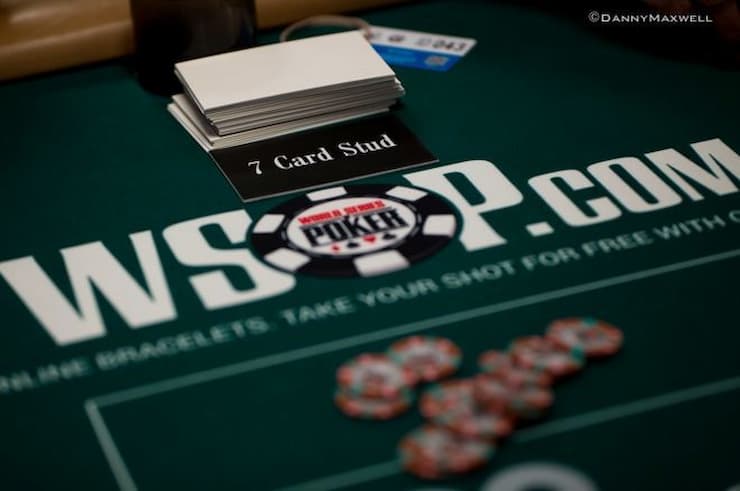If you have ever had an inkling or desire to learn how to play 7 card stud poker, this comprehensive guide is an optimal place to start. This simple yet thorough guide will teach you everything you need to know to get started, build a basic strategy and keep improving your game until you have a good grasp on how to play seven card stud.
What Is Seven-Card Stud?
Seven-Card Stud is a classic poker game in which the goal is to make the best five-card hand out of seven cards that each player is dealt over multiple betting streets. It is one of poker’s oldest and, historically, most popular variants and it is just one of the many games that we cover here on one of the best US poker sites.
Seven-Card Stud History
Seven-Card Stud developed from Five-Card Stud, the oldest variant of poker. It gained popularity in the early 1900s and remained the preeminent poker game for nearly a century. In some places, especially the East Coast of the United States, it held the place of the most popular game all the way to the global poker boom of early 2000s, when it was overtaken by No-Limit Hold’em.
How Does Seven-Card Stud Compare to Texas Hold’em?
Seven-Card Stud has a few similarities to Texas Hold’em. The most basic part of learning how to play seven card stud poker is the hand rankings. They are the same (from royal flush to high card) in both games and also in both, a player gets to use seven cards to make the best five-card hand.
Also in both games, some cards are known to other players, while others are hidden. However, unlike in Hold’em, Seven-Card Stud doesn’t have community cards. Instead, each player gets dealt their own cards.*
*There is only one exception to this rule – if too many players remain in the hand until the river and there aren’t enough cards for everyone, one community card is dealt face-up as the final (river) card.
Another important difference is that Texas Hold’em is mostly played as a no-limit game (Pot Limit and Limit Hold’em also exist, but are much less popular). Stud, on the other hand, is almost always a fixed-limit game, which means that the size of the bets is predetermined. Overall, Texas Hold’em poker strategy and seven card strategy is quite different, so make sure to pay attention closely as you read along.
Variants of Stud
Stud has two other commonly played variants, Razz, and 7-Card Stud Hi-Lo. Razz is a low game, where the objective is to make the lowest hand. We also have more resources for you to find out more about how to play Razz poker. Stud Hi-Lo is a classic split game, where half the pot is won by the high hand and half by the low.
Why Learn Stud Poker?
Despite losing some ground to Texas Hold’em, stud variants of poker still remain the most popular behind Hold’em and Omaha. They are played as standalone games, for example in several tournaments at the World Series of Poker.
Perhaps more notably, stud poker is also a staple of any mixed game. Stud and Razz are a part of the most popular mixed game, H.O.R.S.E., which is played in many events around the world, while other most common mixed games (such as the 8-game or 10-game, Dealer’s Choice etc.), include all three stud variants. Knowing how to play 7 card stud is an important step and goes hand in hand with knowing how to play H.O.R.S.E.

Seven-Card Stud Rules
The first part of seven card stud rules is that players get dealt three cards as their starting hand – two cards face-down (downcards) and one face up (first upcard, called the third street). The next three cards – fourth, fifth and sixth street, are upcards, dealt one at a time, for one betting round each. The last, seventh street, also called the river, is again a downcard.
Players post antes before the deal. Once the cards are dealt, the first betting round starts with the bring-in. This is a forced bet that must be put in by the player showing the lowest upcard. The size of this bet varies between games, but is always lower than the stake of the table. For example, a $20/$40 stud game might have a $5 or $10 bring in.*
*If two players hold the cards of the same value, the bring-in is defined by the suit. Suits are ranked worst to best in an alphabetical order: club, diamond, heart, spade.
The bring-in player has another option: they can complete, which means to bet the lower stake at the table. In our example, that would be $20. This is quite rare, because of the player’s weak card.
Unlike in Hold’em, the betting order in Seven-Card Stud is decided anew every hand and even on every street – it always depends on the board (another commonly used name for upcards). This is a key difference in learning how to play seven card stud.
After the first betting round is started by the player with the worst upcard, the betting on each of the subsequent four streets (4th to 7th street) starts with the player showing the best upcards. The betting on each street then continues clockwise during seven card stud hands.
The betting rules/limits go as follows:
- On the 3rd and 4th street, players can bet or raise the small bet ( the low table stake, $20 in our example).*
- On the 5th, 6th and 7th street, the bet (raise) is the big bet (the high table stake, $40 in our example).
- On each street, there can be a maximum of three raises.
*There is one exception to this rule. On the 4th street, if any of the players is showing a pair with their two upcards, players have the option to choose between the small bet and the big bet (that is until one player chooses the big bet, after that all potential raises have to be the big bet).
These seven card stud poker rules may seem a bit complicated at first, but since the bets are clearly defined, we can’t really make a big betting mistake even when we are just learning. It is still important to understand how big pots can become – this comes with a bit of practice.
Seven-Card Poker Hands – Poker Hand Rankings
Seven-Card Stud is a high-hand game, which means that the winner is the player that makes the highest hand. The hand rankings are the same as in Hold’em and Omaha, so this part should be easy for those who are familiar with the hand rankings from those games, which can be seen on our poker cheat sheet. That cheat sheet can be used in congruence with the below table as a sort of seven card poker cheat sheet.
| Poker Hand Rankings | Example |
|---|---|
| Royal Flush | A♠K♠Q♠J♠10♠ |
| Straight Flush | Q♦J♦10♦9♦8♦ |
| Four of a Kind | 7♣7♠7♦7♥K♣ |
| Full House | J♦J♣J♠5♣5♥ |
| Flush | K♣J♣9♣4♣3♣ |
| Straight | 9♦8♣7♠6♥5♦ |
| Three of a Kind | A♣A♠A♦7♣6♥ |
| Two Pair | Q♦Q♣8♥8♠5♥ |
| One Pair | 10♠10♣8♠6♣2♥ |
| High Card | A♥K♣9♠7♦3♣ |
How to Play Seven Card Stud – Step by Step of a Seven-Card Stud Hand
Let’s take a look at a step by step guide of how a hand of seven card stud works. This will be a key aspect in learning how to play 7 card stud.
- Players post their antes.
- The dealer burns one card and deals each player two hole cards face down and one card face up.
- The player with the lowest upcard bets the bring-in or decides to complete to the lower stake at the table. The betting continues clockwise from the player to the bring-in’s left. Players can either complete, call the bet (whether it was the bring-in or complete), fold their cards, or raise (up to three raises total). The complete does not count as a raise.
- The fourth street is dealt face-up for another round of betting, this time starting with the player showing the best hand. The limit is the small-bet, unless there is a pair on the board.
- The 5th street is dealt to remaining players. Betting begins with the player showing the best hand and continues clockwise. The bet and raise limit is the big bet.
- The 6th street is dealt and played under the same rules as the 5th street.
- The 7th street or the river is dealt to all remaining players face-down. The betting again starts with the player showing the best board.
- In case more than one player remains in the pot when the betting on the 7th street concludes, it is time for the showdown. The player with the best five-card hand takes down the pot.
7-Card Stud Strategy and Tips
There are several important things to keep in mind when considering seven card stud strategy. Let’s look at some useful expert tips for learning how to play stud poker.
Tip 1: Starting hand equities run closer in stud.
Holding a pair of aces as our starting hand is not as strong in Seven-Card Stud as it is in Texas Hold’em. While pocket aces hold a big, 4-to-1 advantage against any other pair in Hold’em, they only hold about a 2-to-1 advantage against another pair in Stud, and around 70% (or around 2.3 to 1) versus most other playable hands (like straight and flush draws).
| Game | Starting Hands | Probabilities | Odds |
|---|---|---|---|
| Hold’em | AdAs vs KdKc | 81.71%% to 17.82% | >4 to 1 |
| Stud | AdAs6h vs KdKc7s | 66.22% to 33.78% | 2 to 1 |
| Stud | KsKh6d vs AhQsQd | 58.23% to 41.77% | 1.4 to 1 |
| Stud | AhAsJd vs 7d8h9s | 70.16% to 29.84% | 2.35 to 1 |
| Stud | KhKdQh vs AsJsTs | 59.76% to 40.23% | 1.5 to 1 |
High pairs are still a great hand in Stud, but it is good to remember that they have a slightly smaller edge against other hands than we may be used to from Hold’em.
Tip 2: It’s all about the board – our opponents’ upcards are just as important as our own cards.
The key thing to understand about 7 card stud strategy is the importance of the board. The same hand can be great in one situation and completely unplayable in another – all based on the cards our opponents are showing.
For example, let’s say we hold JT7 in spades, a hand that has both straight, pair and flush potential. This is a solid speculative hand, but if opponents’ upcards are showing three spades and some of our straight- and pair-outs to boot, this makes our hand pretty much unplayable.
The same goes for pairs, straight draws and other hands – if our opponents are showing cards that we need to improve our hand (to trips, two-pair, straights), we may have to fold an otherwise good-looking, playable hand.
We should pay attention to our opponents cards throughout the hand and see how they affect our and our opponents’ seven card stud hands.
Tip 3: One street can change the situation completely.
Equities run closer in stud because players don’t share any cards. This is absolutely key in seven card stud strategy and something that may take some getting used to for a new player. Because each player gets their own cards, a situation that favors one player can shift on the next street if they hit a bad card while their opponent hits a great one. Because of stud’s limit betting rules, it is also cheaper to continue and see how the hand develops, which means more players will stay in the pot longer.
Tip 4: The magic on the fourth street – playing draws correctly can be very profitable.
Some starting hands are very speculative in terms of general equity, such as three cards of the same suit (e.g. Q86 of hearts) or connectors (e.g. T98). These hands are not amazing starting hands, so we play them carefully. However, if we hit our draw on the fourth street, a lot changes. If we catch a flush draw, we actually become a favorite to win against most hands, and have great equity in multiway pots.
A four-to-a-straight is harder to make on the fourth street (we have 8 outs as opposed to 10 ways to make a flush draw), which is part of the reason why connected hands such as 789 or JTQ are less valuable than suited hands. However, if we do hold an open-ended straight draw on the 4th street, we are also 50/50 against a pair of aces and have great equity in multi way pots (of course, it is always important to pay attention to how the board interacts with our draw).
Tip 5: Bluffing is important in stud.
Many people hold a misconception that any limit game is only about making hands and there isn’t much room for bluffing. But many pros say this could not be further from the truth in stud. There are situations where the board is telling a very scary story to our opponents and this allows for profitable bluffing and stealing.
One of the most frequent bluffs is the steal on the third street, when a player in a later position is showing a high card, like an ace or a king. The antes and the bring-in make the pot worth fighting for. If we are showing an ace and players behind us are showing low cards, this is an opportunity to raise and try to take the pot.
A bluff on later streets may look something like this: let’s say we are showing a Q of spades on the third street and have AK of hearts in the hole, but our upcards come all low spades by the sixth street. We are now showing four spades, so our opponents could (and should) be very scared of a made flush, which we can use to make their pairs and even two-pair hands fold, even if we actually have nothing but a high card and a draw.
Advantages of Seven-Card Stud vs. Other Poker Variants
Seven-Card Stud is a complex game with changes on every street, which gives more advantage to skilled players and allows for a lot of creativity. Because there are many variables, knowing how to play 7 card stud includes players having to be good at reading the situation and adapting, rather than just playing the cards they are holding.
The fact there is so much to consider from the very start of the hand also prevents people having the same popular strategies and playing in a formulaic fashion by relying on charts. Instead, players have to come up with their own understanding of the game, and there is little substitute for experience.
Stud Poker in Popular Culture
While movies, series and music depicting poker nowadays mostly show Texas Hold’em, Seven-Card Stud also got its moments in pop culture, most famously in two scenes in the popular poker movie Rounders. One of the scenes, the Judge’s game, shows Mike, the main character, pull off a bluff by correctly remembering the board and reading other players’ (missed) hands.
Conclusion – How to Play Stud Poker
Some say stud is one of the most difficult games to master, because so many variables affect each hand, and seemingly similar hands can actually play very differently. But for those who invest some time to learn it, it is a game that offers many opportunities for fun and creative play once you learn how to play stud poker. Hopefully, this guide has given you enough reason to take a shot at this unique poker game. Good luck at the tables!






